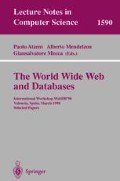Abstract
The navigational behaviour of users in the web is essential for the providers of information, services and goods. Search engines can help a user find a provider of interest, but it is the proper organization of the provider’s site that stimulates the user’s propensity to consume. To verify whether the site is effectively organized, knowledge on the navigation patterns occuring during visits to the site must be obtained. Our Web Utilization Miner WUM can assist in obtaining this knowledge. WUM is a mining system for the discovery of navigation patterns. A navigation pattern is a directed graph that summarizes the traversal movements of a group of visitors and satisfies certain human-centric criteria that make it “interesting”. Instead of focussing the mining process on the statistically dominant but not always interesting patterns, WUM supports the specification of interestingness criteria on their structure, content and statistics.
WUM provides a declarative mining language, MINT, with which the human expert can specify interestingness criteria on the fly. To discover the navigation patterns satisfying the expert’s criteria, WUM exploits an innovative aggregated storage representation for the information in the web server log.
Supported by the German Research Society, Berlin-Brandenburg Graduate School in Distributed Information Systems (DFG grant no. GRK 316).
Access this chapter
Tax calculation will be finalised at checkout
Purchases are for personal use only
Preview
Unable to display preview. Download preview PDF.
References
Agrawal, R., Srikant, R.: Mining sequential patterns. In: ICDE, Taipei, Taiwan (March 1995)
Amir, A., Feldman, R., Kashi, R.: A new and versatile method for association generation. Information Systems 22, 333–347 (1997)
Chen, M.-S., Park, J.S., Yu, P.S.: Data mining for path traversal patterns in a web environment. In: ICDCS, pp. 385–392 (1996)
Cooley, R., Mobasher, B., Srivastava, J.: Grouping web page references into transactions for mining world wide web browsing patterns. Technical Report TR 97-021, Dept. of Computer Science, Univ. of Minnesota, Minneapolis, USA (June 1997)
Cooley, R., Mobasher, B., Srivastava, J.: Web mining: Information and pattern discovery on the world wide web. In: ICTAI 1997 (December 1997)
Feldman, R., Klösgen, W., Zilberstein, A.: Visualization techniques to explore data mining results for document collections. In: KDD 1997, pp. 16–23. AAAI Press, Menlo Park (1997)
Mannila, H., Toivonen, H.: Discovering generalized episodes using minimal occurences. In: KDD 1996, pp. 146–151 (1996)
Pirolli, P., Pitkow, J., Rao, R.: Silk from a sow’s ear: Extracting usable structures from the web. In: CHI 1996, Vancouver, Canada (April 1996)
Silberschatz, A., Tuzhilin, A.: What makes patterns interesting in knowledge discovery systems. IEEE Trans. on Knowledge and Data Eng. 8(6), 970–974 (1996)
Spiliopoulou, M.: The laborious way from data mining to web mining (June 1998) (submitted)
Spiliopoulou, M., Lukas Faulstich, C., Winkler, K.: Discovering Interesting Navigation Patterns over Web Usage Data (1998) (submitted)
Tauscher, L., Greenberg, S.: Revisitation patterns in world wide web navigation. In: CHI 1997, Atlanta, Georgia (March 1997)
Wexelblat, A.: An environment for aiding information-browsing tasks. In: Proc. of AAAI Spring Symposium on Acquisition, Learning and Demonstration: Automating Tasks for Users. AAAI Press, Birmingham (1996)
Wexelblat, A.: Footprints: History-Rich Social Navigation. PhD thesis, MIT Media Laboratory (December 1997)
Winkler, K.: Realization and testing of a data mining environment for the discovery of user navigation patterns in a web site. Master’s thesis, Institut für Wirtschaftsinformatik, HU Berlin (October 1998) (to appear on german)
Author information
Authors and Affiliations
Editor information
Editors and Affiliations
Rights and permissions
Copyright information
© 1999 Springer-Verlag Berlin Heidelberg
About this paper
Cite this paper
Spiliopoulou, M., Faulstich, L.C. (1999). WUM: A Tool for Web Utilization Analysis. In: Atzeni, P., Mendelzon, A., Mecca, G. (eds) The World Wide Web and Databases. WebDB 1998. Lecture Notes in Computer Science, vol 1590. Springer, Berlin, Heidelberg. https://doi.org/10.1007/10704656_12
Download citation
DOI: https://doi.org/10.1007/10704656_12
Publisher Name: Springer, Berlin, Heidelberg
Print ISBN: 978-3-540-65890-0
Online ISBN: 978-3-540-48909-2
eBook Packages: Springer Book Archive

